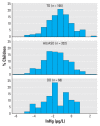Blood mercury concentrations in CHARGE Study children with and without autism
- PMID: 20056569
- PMCID: PMC2831962
- DOI: 10.1289/ehp.0900736
Blood mercury concentrations in CHARGE Study children with and without autism
Abstract
Background: Some authors have reported higher blood mercury (Hg) levels in persons with autism, relative to unaffected controls.
Objectives: We compared blood total Hg concentrations in children with autism or autism spectrum disorder (AU/ASD) and typically developing (TD) controls in population-based samples, and determined the role of fish consumption in differences observed.
Methods: The Childhood Autism Risk from Genetics and the Environment (CHARGE) Study enrolled children 2-5 years of age. After diagnostic evaluation, we analyzed three groups: AU/ASD, non-AU/ASD with developmental delay (DD), and population-based TD controls. Mothers were interviewed about household, medical, and dietary exposures. Blood Hg was measured by inductively coupled plasma mass spectrometry. Multiple linear regression analysis was conducted (n = 452) to predict blood Hg from diagnostic status controlling for Hg sources.
Results: Fish consumption strongly predicted total Hg concentration. AU/ASD children ate less fish. After adjustment for fish and other Hg sources, blood Hg levels in AU/ASD children were similar to those of TD children (p = 0.75); this was also true among non-fish eaters (p = 0.73). The direct effect of AU/ASD diagnosis on blood Hg not through the indirect pathway of altered fish consumption was a 12% reduction. DD children had lower blood Hg concentrations in all analyses. Dental amalgams in children with gum-chewing or teeth-grinding habits predicted higher levels.
Conclusions: After accounting for dietary and other differences in Hg exposures, total Hg in blood was neither elevated nor reduced in CHARGE Study preschoolers with AU/ASD compared with unaffected controls, and resembled those of nationally representative samples.
Figures


Similar articles
-
Prenatal mercury exposure, autism, and developmental delay, using pharmacokinetic combination of newborn blood concentrations and questionnaire data: a case control study.Environ Health. 2015 Jul 22;14:62. doi: 10.1186/s12940-015-0045-4. Environ Health. 2015. PMID: 26198445 Free PMC article.
-
Altered urinary porphyrins and mercury exposure as biomarkers for autism severity in Egyptian children with autism spectrum disorder.Metab Brain Dis. 2016 Dec;31(6):1419-1426. doi: 10.1007/s11011-016-9870-6. Epub 2016 Jul 13. Metab Brain Dis. 2016. PMID: 27406246
-
Phthalate concentrations in house dust in relation to autism spectrum disorder and developmental delay in the CHildhood Autism Risks from Genetics and the Environment (CHARGE) study.Environ Health. 2015 Jun 26;14:56. doi: 10.1186/s12940-015-0024-9. Environ Health. 2015. PMID: 26108271 Free PMC article.
-
A profile and review of findings from the Early Markers for Autism study: unique contributions from a population-based case-control study in California.Mol Autism. 2021 Mar 18;12(1):24. doi: 10.1186/s13229-021-00429-7. Mol Autism. 2021. PMID: 33736683 Free PMC article. Review.
-
Systematic Assessment of Research on Autism Spectrum Disorder (ASD) and Mercury Reveals Conflicts of Interest and the Need for Transparency in Autism Research.Sci Eng Ethics. 2017 Dec;23(6):1691-1718. doi: 10.1007/s11948-017-9983-2. Sci Eng Ethics. 2017. Retraction in: Sci Eng Ethics. 2017 Dec;23(6):1689-1690. doi: 10.1007/s11948-015-9713-6. PMID: 29119411 Free PMC article. Retracted. Review.
Cited by
-
Autism spectrum disorder phenotypes and prenatal exposure to methylmercury.Epidemiology. 2013 Sep;24(5):651-9. doi: 10.1097/EDE.0b013e31829d2651. Epidemiology. 2013. PMID: 23873071 Free PMC article.
-
Blood lead concentrations in Jamaican children with and without autism spectrum disorder.Int J Environ Res Public Health. 2014 Dec 23;12(1):83-105. doi: 10.3390/ijerph120100083. Int J Environ Res Public Health. 2014. PMID: 25546274 Free PMC article.
-
Complementary and alternative medicine in autism: an evidence-based approach to negotiating safe and efficacious interventions with families.Neurotherapeutics. 2010 Jul;7(3):307-19. doi: 10.1016/j.nurt.2010.05.002. Neurotherapeutics. 2010. PMID: 20643384 Free PMC article. Review.
-
More than half of US youth consume seafood and most have blood mercury concentrations below the EPA reference level, 2009-2012.J Nutr. 2015 Feb;145(2):322-7. doi: 10.3945/jn.114.203786. Epub 2014 Dec 17. J Nutr. 2015. PMID: 25644354 Free PMC article.
-
Chemicals, Nutrition, and Autism Spectrum Disorder: A Mini-Review.Front Neurosci. 2016 Apr 20;10:174. doi: 10.3389/fnins.2016.00174. eCollection 2016. Front Neurosci. 2016. PMID: 27147957 Free PMC article. Review.
References
-
- American Psychiatric Association. Diagnostic and Statistical Manual of Mental Disorders. 4th ed. Arlington, VA: American Psychiatric Publishing; 2000.
-
- Beyrouty P, Chan HM. Co-consumption of selenium and vitamin E altered the reproductive and developmental toxicity of methylmercury in rats. Neurotoxicol Teratol. 2006;28(1):49–58. - PubMed
-
- Centers for Disease Control and Prevention. Blood mercury levels in young children and childbearing-aged women—United States, 1999–2002. MMWR Morb Mortal Wkly Rep. 2004;53(43):1018–1020. - PubMed
Publication types
MeSH terms
Substances
Grants and funding
LinkOut - more resources
Full Text Sources
Medical
Research Materials

